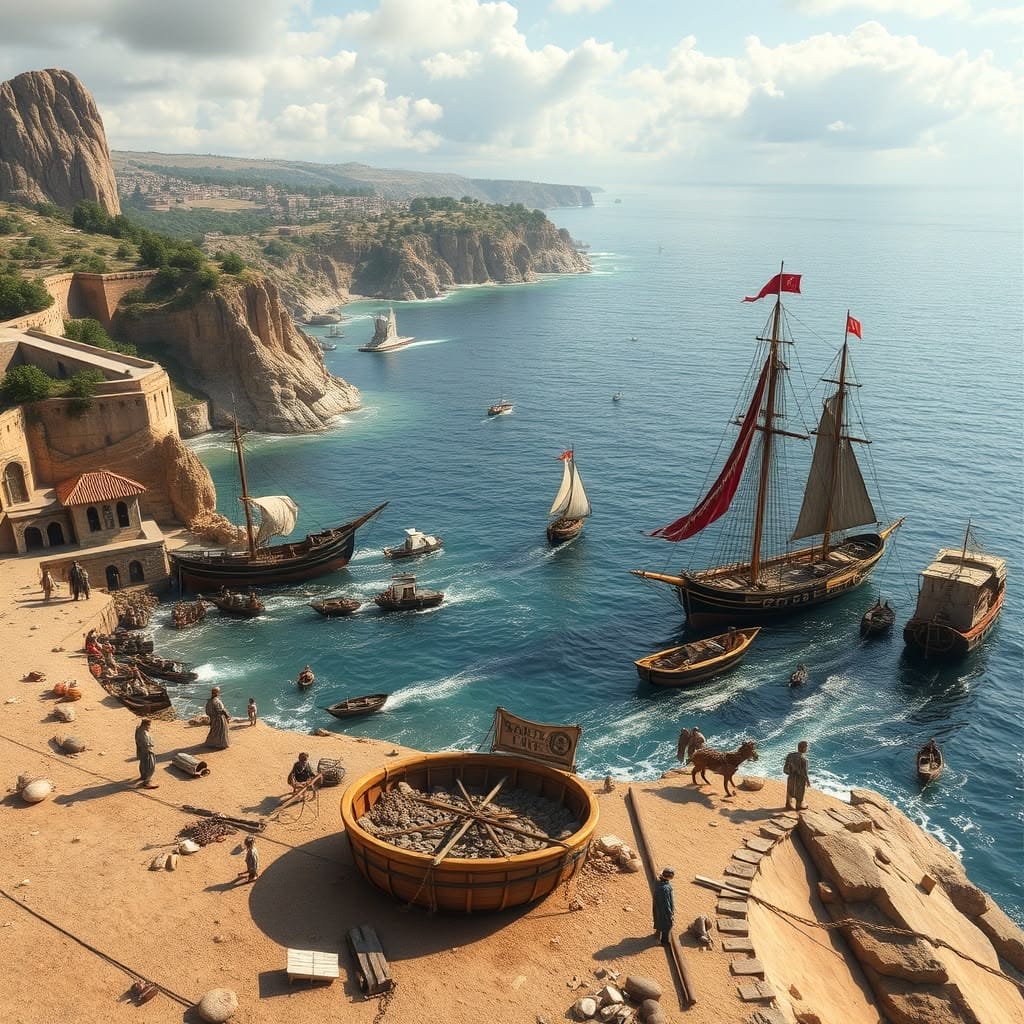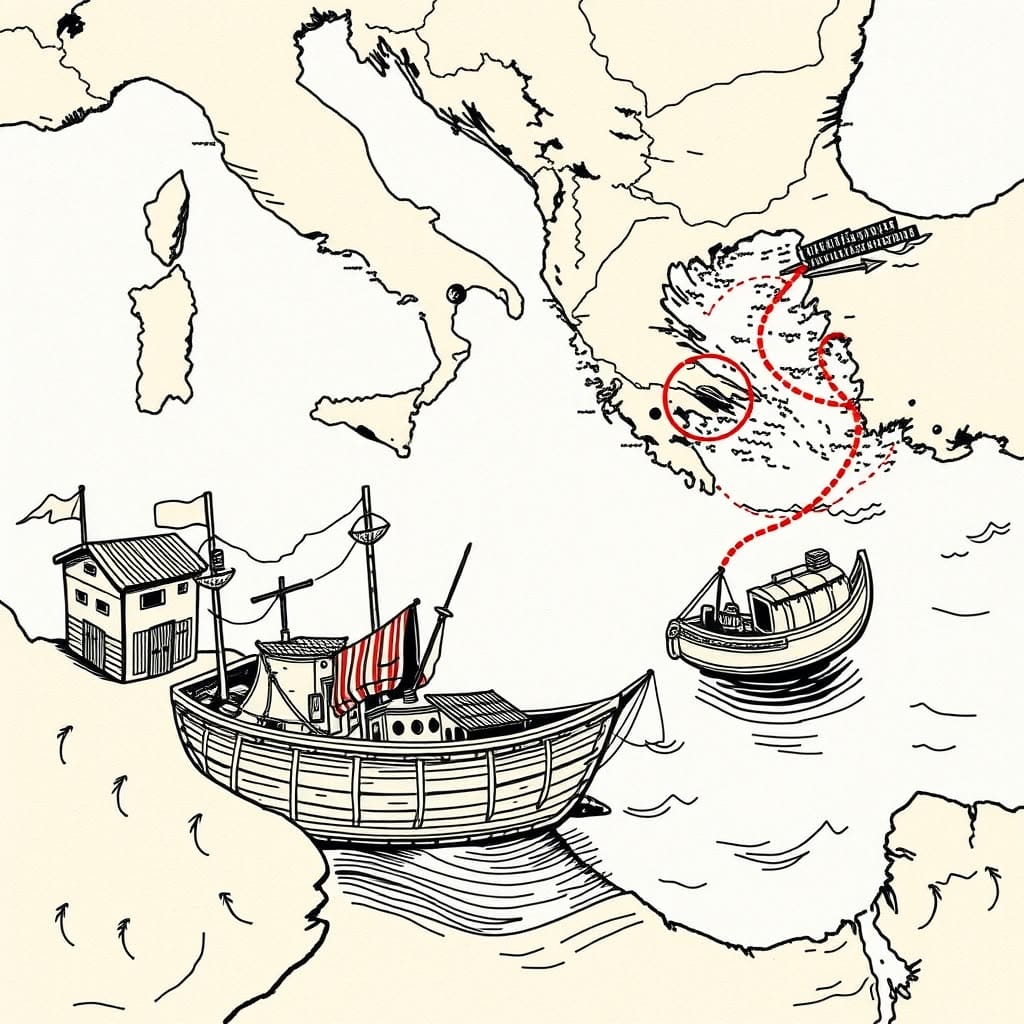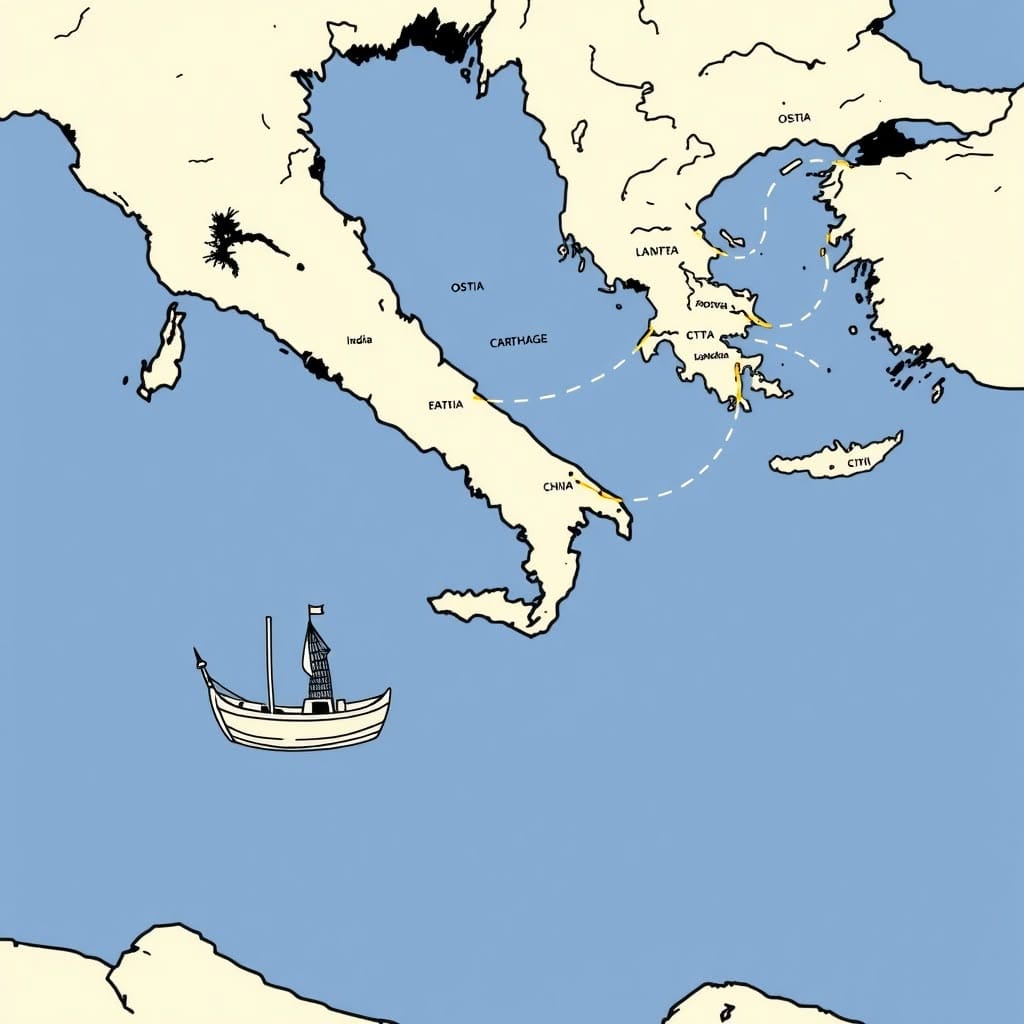Ancient Rome’s economic prosperity and expansion were heavily reliant on maritime trade, which served as a cornerstone of its economic infrastructure. The Mediterranean Sea, affectionately known as ‘Mare Nostrum’ or ‘Our Sea’ by the Romans, was the central trade route that seamlessly connected the empire’s vast territories.
This vital maritime highway facilitated the exchange of essential goods such as grain from Egypt and North Africa, and luxury items like silk and spices from the East. The Mediterranean’s geographical advantage provided Rome with the means to establish extensive trade networks, significantly contributing to its economic prosperity and cultural enrichment. As such, the sea routes were crucial not only for commerce but also for cultural exchanges and military logistics, reinforcing the empire’s power and influence across its territories.
Major Ports of Ancient Rome
Ostia: Gateway to Rome
Located at the mouth of the Tiber River, Ostia was Ancient Rome’s primary port, crucial for the city’s trade and commerce. Its strategic position allowed seamless access to the Mediterranean, facilitating the influx of essential goods such as grain, wine, and olive oil. Ostia’s advanced infrastructure, including warehouses and docks, enabled efficient handling of large cargo volumes. As a bustling trade hub, it was a melting pot of cultures, contributing to the Roman Empire’s diversity and serving military logistics.
Alexandria: Egypt’s Trade Hub
Alexandria was a pivotal Mediterranean port, strategically positioned at the crossroads of Europe, Asia, and Africa. Its natural harbor made it one of the busiest ports, channeling goods like grain and luxury items vital to the Roman economy. The Lighthouse of Alexandria, a symbol of its wealth, guided ships safely to port. The city’s vibrant marketplace, enriched by its diverse population, and the Great Library, underscored its cultural and intellectual significance.
Carthage: Strategic Maritime Power
Carthage, positioned near the Strait of Sicily, was vital in controlling maritime routes between Europe, Africa, and the Near East. This strategic location allowed it to dominate naval trade routes, enhancing its economic power. Carthage’s formidable navy protected its trade interests, but its rivalry with Rome eventually led to its downfall. The defeat in the Punic Wars marked Rome’s dominance over the Mediterranean, reshaping trade dynamics.

Trade Goods and Commodities
The Roman Empire’s vast trade networks facilitated the import of a diverse range of goods, particularly from regions like India and China. These imported items played a significant role in shaping the Roman economy and culture.
- Spices: Highly sought after for culinary and medicinal purposes, Indian spices were a staple in Roman trade.
- Textiles: Luxurious silk and cotton fabrics from India were prized for their quality.
- Gems and Precious Stones: Gemstones, including diamonds and pearls, were immensely popular among the Roman elite.
- Exotic Animals: Elephants and peacocks served as symbols of wealth and were used in entertainment.
- Incense: Aromatic resins were imported for religious and ceremonial uses.
In addition to imports, the Roman Empire thrived on its local goods production. The empire’s provinces specialized in producing goods based on local resources, such as wine from Gaul and grain from Egypt. Artisans in cities like Pompeii crafted high-quality ceramics and mosaics, while agricultural products like olives, grapes, and grains were essential for trade.
These commodities not only enriched the Roman economy by facilitating wealth creation and job opportunities but also promoted cultural exchanges, linking Rome with distant lands and introducing foreign influences into Roman society.

Roman Naval Power
The Roman navy was instrumental in safeguarding maritime trade routes from piracy, a significant threat to the economic stability of the Roman Empire. Recognizing the dangers posed by pirates, the Romans established a formidable naval force dedicated to patrolling and securing the Mediterranean Sea. Roman ships regularly conducted patrols, maintaining a visible presence that deterred pirate activity and ensured the safe passage of goods.
Strategically, the Romans implemented blockades and executed military campaigns against pirate strongholds, particularly in areas like Cilicia. These efforts involved both naval and land forces, effectively neutralizing pirate threats. Additionally, the Roman government enacted laws to arrest and prosecute pirates, creating a legal framework that further discouraged piracy.
Naval bases along key trade routes allowed for swift responses to threats, bolstering the protection of merchant vessels. This infrastructure was crucial for maintaining logistics and supply lines, enabling efficient transportation of troops and resources across the sea. The Roman navy also played a diplomatic role, establishing relations with other maritime powers to secure trade agreements and ensure safe passage for Roman merchants.
By protecting trade routes and facilitating the flow of goods, the Roman navy significantly contributed to the empire’s prosperity and economic growth.

Impact of Maritime Trade on Roman Economy
The extensive maritime trade network of Ancient Rome significantly contributed to the empire’s economic prosperity. By securing vital sea routes, the Roman navy enabled a steady influx of goods, which bolstered the economy. Historical records suggest that trade across the Mediterranean accounted for a substantial portion of the empire’s wealth, highlighting the importance of these maritime activities.
“The prosperity of the Roman Empire relied heavily on the seas,” noted historian Pliny the Elder. This statement underscores the crucial role that maritime trade played in creating wealth and job opportunities. The bustling ports of Ostia, Alexandria, and Carthage facilitated the exchange of goods, generating employment in shipbuilding, logistics, and mercantile activities.
Moreover, the protection provided by the Roman navy ensured the safe passage of goods, allowing trade to thrive without the fear of piracy. Such stability encouraged economic growth, as merchants felt secure to invest in long-distance trade ventures. Consequently, the Roman economy witnessed an influx of exotic goods and an expansion of market reach, which were instrumental in sustaining the empire’s economic dominance.

Cultural Exchanges Through Trade
The maritime trade networks of Ancient Rome were pivotal in facilitating cultural exchanges between Rome and distant regions. Roman merchants, navigating the Mediterranean Sea, interacted with diverse cultures, integrating foreign influences into Roman society. The influx of exotic goods, such as silk from China and spices from India, not only enriched Roman material culture but also transformed aspects of Roman life, including fashion, cuisine, and religious practices.
Such interactions were reciprocal, as Roman customs and practices disseminated along trade routes. For instance, Roman art and architectural styles influenced local designs in North Africa and the Near East, demonstrating the far-reaching impact of Roman culture. The spread of Roman legal and administrative systems further exemplifies this exchange.
Moreover, the movement of people, including artisans and scholars, facilitated the exchange of ideas and technologies. This led to a blending of traditions, which enriched the Roman cultural landscape. Over time, the integration of foreign elements into Roman society fostered a rich tapestry of shared traditions, which laid the groundwork for enduring cultural legacies that continued to influence subsequent civilizations.

Challenges in Maritime Trade
Maritime trade in Ancient Rome was fraught with numerous challenges that required careful navigation and strategic responses. Among these, piracy was a persistent threat. The Mediterranean Sea was a hotspot for pirate activity, leading to increased costs in protection, insurance, and sometimes ransoms, all of which ultimately raised consumer prices.
Natural obstacles further complicated trade. Unpredictable weather conditions and limited navigational technology posed significant risks, often resulting in shipwrecks and lost goods. Political and economic fluctuations presented additional hurdles:
- Political Instability: Shifts in power and regional conflicts could disrupt trade agreements, making certain routes risky for merchants.
- Regulatory Challenges: Varying laws and tariffs across regions complicated trade, increasing the burden on merchants.
- Competition: Rivalries between cities and regions could lead to trade restrictions, affecting the flow of goods.
These challenges necessitated innovative risk management strategies by Roman traders, who had to constantly adapt to the evolving maritime landscape to maintain the flow of goods across the empire.

Innovations in Maritime Technology
In response to the myriad challenges faced in Roman maritime trade, significant advancements in technology emerged, particularly in shipbuilding and navigation techniques.
Roman shipbuilders enhanced vessel designs to improve durability and cargo capacity. The development of the Corbita, a large merchant ship, exemplifies these advancements, allowing for more efficient transport of goods across the Mediterranean.
In terms of navigation, limited techniques initially relied heavily on celestial bodies and coastal landmarks. However, innovations like the gnomon, a simple shadow-casting device, helped sailors better estimate their position at sea.
| Technique | Old Method | New Innovation |
|---|---|---|
| Shipbuilding | Basic wooden vessels | Corbita with increased cargo capacity |
| Navigation | Landmarks and stars | Gnomon for solar tracking |
These technological innovations not only facilitated safer and more efficient maritime trade but also laid the groundwork for the future of global trade practices.

Legacy of Roman Maritime Trade
The Roman maritime trade has left a lasting imprint on modern trade routes and global trade practices. The extensive network established by Roman merchants across the Mediterranean laid the groundwork for contemporary shipping lanes. These routes continue to influence today’s maritime logistics, demonstrating the enduring legacy of Roman trade.
Furthermore, Roman innovations in maritime technology and management have significantly shaped modern trade operations. The emphasis on risk management in response to challenges such as piracy, which included military campaigns and naval patrols, set precedents for current maritime security measures.
Additionally, the Romans’ ability to navigate diverse regulatory environments and infrastructural limitations paved the way for today’s complex global trade systems. By addressing issues like political instability and port infrastructure, Roman traders developed strategies that resonate in modern international commerce.
Ultimately, the Roman Empire’s approach to maritime trade not only shaped the economic landscape of its time but also established principles that continue to guide trade practices worldwide, underscoring the significance of their contributions to global economic development.

FAQ on Roman Maritime Trade
What were the main challenges faced by Roman maritime traders?
Roman maritime traders encountered numerous challenges, such as piracy, unpredictable weather, and limited navigational technology. These issues often led to increased costs and risks in shipping goods across the Mediterranean.
How did Rome deal with piracy on its trade routes?
The Roman government responded to the threat of piracy through military campaigns and the establishment of naval patrols. Despite these efforts, piracy remained a significant issue, leading to shifts in trade routes and economic power, as merchants sought safer alternatives.
Did political instability affect Roman maritime trade?
Yes, political instability and conflicts often impacted trade agreements and routes. Changes in political power could make it risky for merchants to operate in certain regions, complicating trade operations.
Is it true that Roman ports were well-equipped for trade?
While some major ports were well-equipped, many lacked adequate facilities for loading and unloading goods. This often slowed down trade operations and increased costs for merchants.
Were Roman trade practices uniform across the empire?
No, different regions had varying laws and tariffs, creating regulatory challenges for merchants. These differences required traders to be adaptable and knowledgeable about local regulations to successfully conduct business.

Conclusion
Throughout this exploration of Roman maritime trade, we observed the critical role of the Mediterranean Sea routes in the empire’s prosperity. **Major ports** like Ostia, Alexandria, and Carthage functioned as pivotal trade hubs, facilitating the movement of goods from distant lands such as India and China. The Roman **naval power** provided essential protection against piracy, despite ongoing challenges from weather, navigation, and political instability. These maritime activities not only bolstered the Roman economy but also promoted cultural exchanges, shaping the society of the era. Ultimately, the enduring impact of Roman maritime trade is evident in today’s global trade practices, underscoring its historical significance and legacy.

